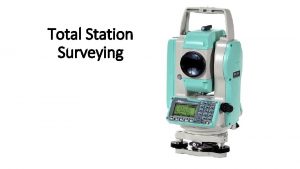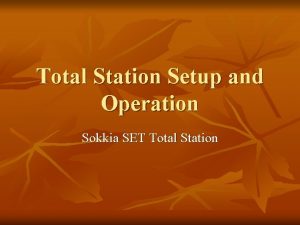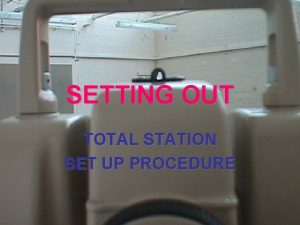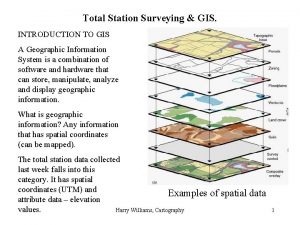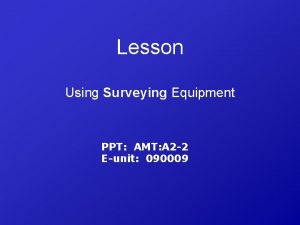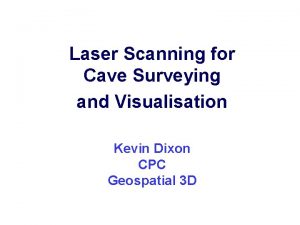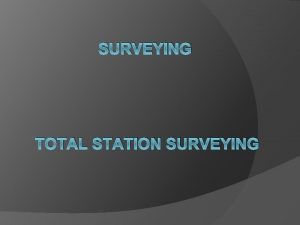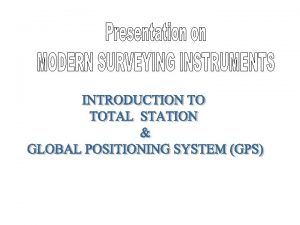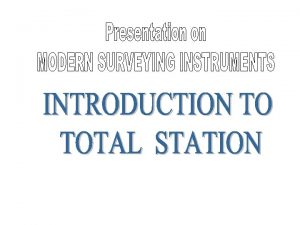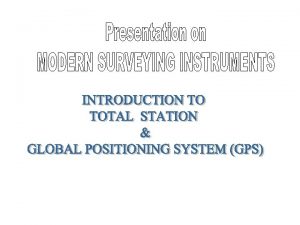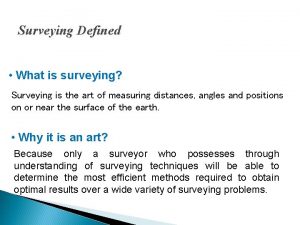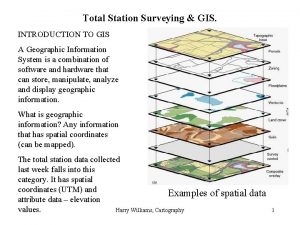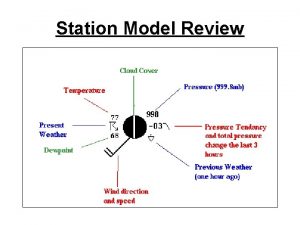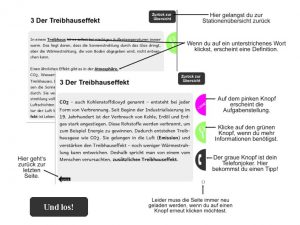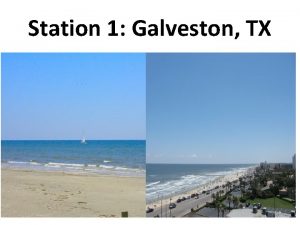UNIT V MODERN SURVEYING 1 Total station surveying




















- Slides: 20

UNIT V MODERN SURVEYING 1

Total station surveying • Total station surveying - defined as the use of electronic survey equipment used to perform horizontal and vertical measurements in reference to a grid system (e. g. UTM, mine grid).

Total Station: • A Total Station is a modern surveying instrument that integrates an electronic theodolite with an electronic distance meter. Total Stations use electronic transit theodolites in conjunction with a distance meter to read any slope distance from the instrument to any particular spot. They are hence two essential surveying instruments in one and when used with other technology such as mapping software able to deliver the 'total' surveying package, from measuring to mapping.

Total station is a combination of : • • • EDM Theodolite Auto Leveler Microprocessor with specific memory Battery/spare which works about 5 working hours About 100 models were released till now by different firms.

Field techniques with total station • • • Point location Slope reduction Missing line measurement (MLM) Resection Azimuth calculation Remote distance and elevation measurement Offset measurements Layout or setting out operation Area computation Tracking Stakeout

Types of Total Station Surveying • Slope Staking , Topographic surveys, Construction project layout , Leveling Traverse surveys and adjustments, Building Face Surveys, Resections , Areas, Intersections, Point Projections, Taping from Baseline.

BASIC PRINCIPLE • Although taping and theodolites are used regularly on site – total stations are also used extensively in surveying, civil engineering and construction because they can measure both distances and angles. • Because the instrument combines both angle and distance measurement in the same unit, it is known as an integrated total station which can measure horizontal and vertical angles as well as slope distances.

• Using the vertical angle, the total station calculate the horizontal and vertical distance components of the measured slope distance. • As well as basic functions, total stations are able to perform a number of different survey tasks and associated calculations and can store large amounts of data. • As with the electronic theodolite, all the functions of a total station are controlled by its microprocessor, which is accessed thought a keyboard and display.

To use the total station, it is set over one end of the line to be measured and some reflector is positioned at the other end such that the line of sight between the instrument and the reflector is unobstructed (as seen in the figure below). -The reflector is a prism attached to a detail pole -The telescope is aligned and pointed at the prism -The measuring sequence is initiated and a signal is sent to the reflector and a part of this signal is returned to the total station -This signal is then analysed to calculate the slope distance together with t he horizontal and vertical angles. -Total stations can also be used without reflectors and the telescope is pointed at the point that needs to be measured -Some instruments have motorised drivers and can be use automatic target recognition to search and lock into a prism – this is a fully automated process and does not require an operator. -Some total stations can be controlled from the detail pole, enabling surveys to be conducted by one person

the advantages of Total Station • Relatively quick collection of information • Multiple surveys can be performed at one set-up location. • Easy to perform distance and horizontal measurements with simultaneous calculation of project coordinates (Northings, Eastings, and Elevations). • Layout of construction site quickly and efficiently. • • Digital design data from CAD programs can be uploaded to data collector. • Daily survey information can also be quickly downloaded into CAD which eliminates data manipulation time required using conventional survey techniques.

the disadvantages of Total Station • Vertical elevation accuracy not as accurate as using conventional survey level and rod technique. • Horizontal coordinates are calculated on a rectangular grid system. • However, the real world should be based on a spheroid and rectangular coordinates must be transformed to geographic coordinates if projects are large scale. • Examples : highways, large buildings, etc. • As with any computer-based application “Garbage in equals • Garbage out”. However, in the case of inaccurate construction surveys “Garbage in equals lawsuits and contractors claims for extras. ”

measuring principle of electro optical system • The general principle involves sending a modulated Electro-magnetic (EM) beam from one transmitter at the master station to a reflector at the remote station and receiving it back at the master station. The instrument measures slope distance between transmitter and receiver by modulating the continuous carrier wave at different frequencies, and then measuring the phase difference at the master station between the outgoing and the incoming signals.

• This establishes the following relationship for a double distance (2 D): • Where m is unknown integer number of complete wavelengths contained within double distance, Φ; is the measured phase difference and λ is modulation wavelength, and k is constant. Multiple modulation frequencies are used to evaluatem , the ambiguity.

the different types of EDM (i) wavelength used (ii) working range (iii) achievable accuracy

Classification on the basis of wavelength • Present generation EDMIs use the following types of wavelengths (Schoffield, 2001): • (a) infrared (b) laser (c) microwaves • The first two types of systems are also known as electro-optical whereas the third category is also called the electronic system.

Electro Optical system • Infrared: Systems employing these frequencies allow use of optical corner reflectors (special type of reflectors to return the signal, explained later) but need optically clear path between two stations. These systems use transmitter at one end of line and a reflecting prism or target at the other end.

Laser: These systems also use transmitter at one end of line and may or may not use a reflecting prism or target at the other end. However, the reflectorless laser instruments are used for short distances (100 m to 350 m). These use light reflected off the feature to be measured (say a wall).

The working principle of Electrooptical system or EDM • An EDM uses electromagnetic (EM) energy to determine the length of a line. The energy originates at an instrument at one end of a line and is transmitted to a "reflector" at the other end from where it is returned to the originating instrument.

The working principle of Electrooptical system or EDM • The nature of the "reflector" is dependant on the type of EM. If electro-optical (infrared or laser) EM is used then the "reflector" is typically a passive medium which bounces the signal back. If the EM is microwave, then the reflector is a second instrument which captures the incoming energy and re-transits it back to the originating instrument.

Thank You 20
 Basic principle of total station
Basic principle of total station How to setup total station
How to setup total station Temporary adjustment of level
Temporary adjustment of level Gis total station
Gis total station Distance measuring equipment ppt
Distance measuring equipment ppt Total station visualisation
Total station visualisation Pasivo total sobre activo total
Pasivo total sobre activo total Total revenues minus total costs equals
Total revenues minus total costs equals Total revenues minus total costs equals
Total revenues minus total costs equals Total revenues minus total costs equals
Total revenues minus total costs equals Total revenue minus total expenses
Total revenue minus total expenses Unit 6 review questions
Unit 6 review questions Cvp graph
Cvp graph Total variable cost per unit
Total variable cost per unit Unit 7 modern ga and civil rights
Unit 7 modern ga and civil rights Suatu lembaga yang
Suatu lembaga yang Right triangle trigonometry
Right triangle trigonometry English unit conversions
English unit conversions Algebra 2 unit 1 test answers
Algebra 2 unit 1 test answers Perhitungan unit cost rekam medis
Perhitungan unit cost rekam medis Unit process and unit operation
Unit process and unit operation
